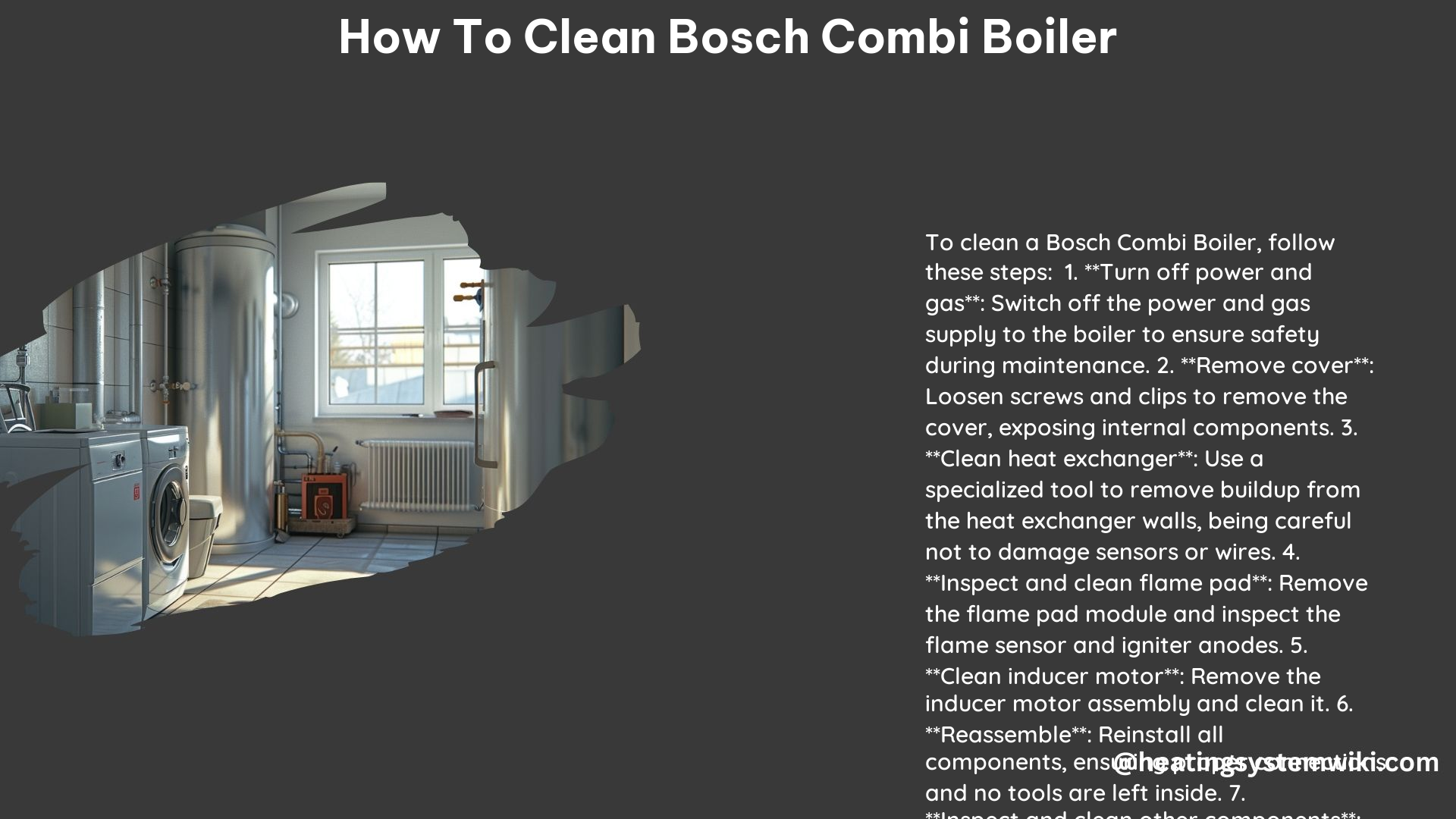Maintaining a Bosch combi boiler is crucial for ensuring its efficient and safe operation. This comprehensive guide will walk you through the step-by-step process of cleaning your Bosch combi boiler, covering everything from inspecting the exterior and interior to performing a combustion test. Whether you’re a DIY enthusiast or a professional technician, this guide will provide you with the technical details and best practices to keep your Bosch combi boiler in top condition.
Turning Off the Power and Gas Supply
Before starting any maintenance or cleaning tasks, it’s essential to ensure the boiler is turned off and the gas supply is shut off. This step is crucial for your safety and the proper functioning of the boiler. Disconnect the power supply to the boiler and shut off the gas valve to prevent any accidental ignition or gas leaks during the cleaning process.
Inspecting the Exterior and Interior

Visually inspect the exterior and interior of the boiler for any signs of damage, discoloration, or leaks. Pay close attention to the exhaust vent connection, exhaust pipe, and exhaust termination, as these components can be susceptible to damage, leaks, discoloration, or blockages. Carefully examine the boiler’s casing, panels, and connections for any issues that may require further attention.
Cleaning the Condensate Trap and Refilling with Fresh Water
The condensate trap is responsible for collecting and discharging the condensate produced by the boiler’s operation. Over time, this trap can become clogged with debris, which can lead to issues with the boiler’s operation. Carefully remove the condensate trap, clean it thoroughly, and refill it with fresh water to ensure proper condensate discharge.
Cleaning the Air Intake Filter and Water Filter
The air intake filter and water filter play a crucial role in maintaining proper airflow and water quality within the boiler. Regularly cleaning these filters helps to prevent blockages and ensures the boiler operates at its optimal efficiency. Use a soft-bristled brush or a vacuum cleaner to remove any accumulated dust or debris from the filters.
Inspecting and Cleaning the Heat Exchanger
The heat exchanger is the heart of the boiler, responsible for transferring heat from the combustion process to the water. Over time, the heat exchanger can accumulate deposits and buildup, which can reduce its efficiency. Use a specialized tool, such as a cheese grater, to carefully remove any buildup from the walls of the heat exchanger. Exercise caution to avoid damaging any sensors or wires during this process.
Inspecting and Cleaning the Ignition Electrodes and Flame Sensing Rod
The ignition electrodes and flame sensing rod play a critical role in the boiler’s ignition and flame detection system. Remove the flame pad and inspect these components for any signs of wear or damage. Clean the electrodes and flame sensing rod using a soft-bristled brush or emery cloth to ensure proper ignition and flame detection.
Inspecting the Combustion Chamber and Burner Tube
The combustion chamber and burner tube are responsible for the efficient and safe combustion of the fuel. Inspect these components for any buildup or debris and clean them thoroughly to maintain proper combustion.
Inspecting and Cleaning the Condensate Discharge System
Ensure the condensate discharge system is functioning correctly by inspecting it for any blockages or issues. Clean the system if necessary to prevent any issues with the boiler’s operation.
Checking System Pressure and Wiring Connections
Verify the system pressure, both gas and water, is within the recommended range. Inspect all wiring connections for any signs of damage or corrosion, and address any issues found.
Performing a Combustion Test
Conduct a combustion test to ensure the boiler is operating efficiently and safely. This test will help you identify any issues with the combustion process and make any necessary adjustments to optimize the boiler’s performance.
Inspecting the Flue and Air Intake System
Examine the flue and air intake system, including the venturi and fan, for any damage or blockages. Address any issues found to maintain proper airflow and prevent any potential safety concerns.
Checking the Safety Block and Modulation Range
Verify that the safety block is functioning correctly and the modulation range is set properly. This step helps to ensure the boiler’s safety features are working as intended and the boiler is operating within its designed parameters.
Verifying Correct Startup and Operation
After completing all the maintenance and cleaning tasks, ensure the boiler starts up and operates correctly. Monitor the boiler’s performance to confirm it is functioning as expected.
Additional Tips
- Perform annual maintenance tasks, such as inspecting the hydraulic system pressure, pressure relief valve, and low water cutoff switch.
- Conduct monthly and bi-monthly checks on the condensate discharge system and low water cutoff switch.
- If you are not qualified to perform these tasks, hire a professional to ensure the boiler is maintained and cleaned correctly.
Technical Specifications
- Boiler type: Bosch Greenstar Combi Boiler
- Maintenance frequency: Daily, monthly, bi-monthly, and annually
- Tools required: Phillips head screwdriver, wrench, vacuum, heat exchanger tool (cheese grater), and other specialized tools as needed
References
- Bosch Home Comfort. (n.d.). Condensing Gas Boilers Maintenance Information. Retrieved from https://www.bosch-homecomfort.com/us/en/residential/service-support/technical-support/product-maintenance-information/condensing-gas-boilers-maintenance-information/
- YouTube. (2022). Tankless Flush and Maintenance on a Bosch Greenstar!!! 10 Year… Retrieved from https://www.youtube.com/watch?v=ukXrU4Kd5zM
- YouTube. (2022). Bosch Boiler – How to Clean, and Maintain – YouTube. Retrieved from https://www.youtube.com/watch?v=Fb7UIKpfytc
